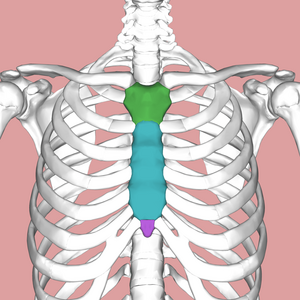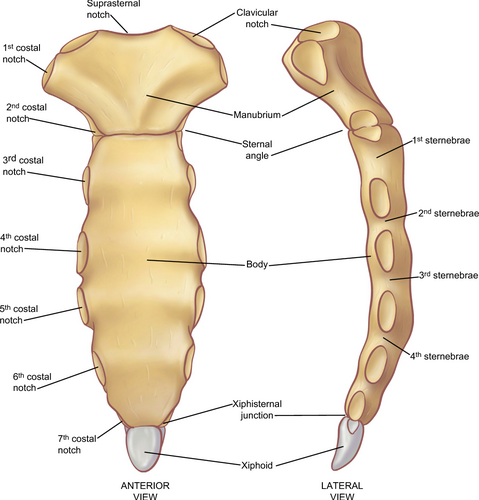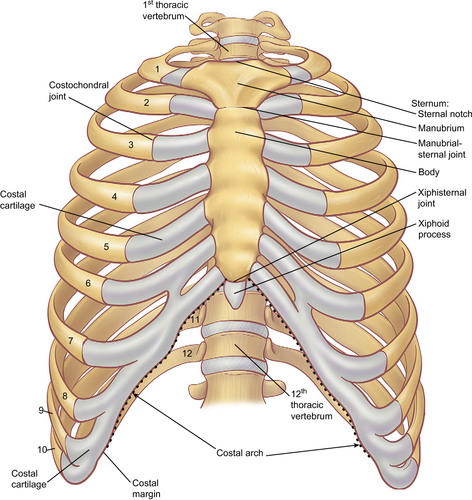Sternum
Original Editor - Grace Barla
Top Contributors - Grace Barla, Kim Jackson, Vaibhav Panchal, Lucinda hampton and Vidya Acharya
Description[edit | edit source]
The sternum is a flat cancellous bone with a compact cortex, it is slightly convex anteriorly, with multiple indentations along its lateral borders (costal notches). It forms the anterior median part of the thoracic skeleton. It is commonly known as the breastbone. In shape it resembles like a short sword. The sternum is located along the midline of body in the anterior thoracic region just deep to the skin. It is a flat bone about six inches in length, around an inch wide, and only a fraction of an inch thick. it is longer in males than in females.
Structure[edit | edit source]
The sternum develops as three distinct parts:
- The manubrium
- The body of the sternum
- The xiphoid process
Manubrium
- Manubrium is at the cephalad end of the sternum is the large, flat, wide. At the superior border of the bone there is jugular notch or suprasternal notch. The clavicular notches for the articulation of clavicles are projected upward and laterally on both sides of jugular notch.
- It has two surfaces :
- Anterior surface - It is convex from side to side and concave from above downwards.
- Posterior surface - It is concave and forms the anterior boundary of the superior mediastinum.
Four borders :
- superior border - thick, rounded and concave.
- inferior border - it forms a secondary cartilaginous joint with the body of the sternum.
The manubrium makes angle with the body, convex forwards, called as the sternal angle of Louis. certain events take place at this angle -
- Formation of cardiac plexus
- Upper limit of base of heart
- Arch of aorta starts here as continuation of ascending aorta.
- Arch of aorta ends here to continue as descending thoracic aorta.
- Trachea divides into 2 branches.
- The body
- The body of the sternum is the longest region of the sternum and is roughly rectangular in shape. It is also known as gladiolus
Function[edit | edit source]
Articulations[edit | edit source]
The structure is relatively fixed at its cephalad end because it articulates principally with the first rib and the clavicle. Because it is anchored superiorly, it moves anteriorly and upward only slightly to elevate the first and second ribs. As noted, these ribs are relatively short and flat and contribute little to the increase in the internal diameter of the cylinder (ie, the chest wall). The second cartilage articulates with both the manubrium and the body of the sternum, the gladiolus. The gladiolus, the largest and flattest part of the sternum, articulates with the ribs 2 through 7. Rib 7 joins the sternum at the junction between the xiphoid process and the gladiolus. When the sternum is in motion, the top of the manubrium is fixed, and the inferior aspect elevates anteriorly and cephalad. The joint between the manubrium and the gladiolus moves most, with the articulation allowing the body of the sternum to move anteriorly and to progress cephalad. As it does so, it draws the ribs, which articulate with it, upward and outward, increasing the transverse diameter of the chest significantly so that more air exchange occurs in the lungs, which follow the movement of the chest wall. The xiphoid process itself is small and is of little consequence. Even though it articulates partially with the seventh rib, it contributes little to chest wall anatomy and physiology. The first is an anterior projection showing the wide, flat manubrium, which is relatively fixed at the cephalad end of the sternum. Articulation here is only between ribs 1 and 2 and the manubrium. The cartilages from ribs 1 and 2 articulate with the manubrium, but the cartilage from rib 2 also articulates with the body of the sternum. The main articulations with the body of the sternum are with cartilages 2, 3, 4, 5, 6, and 7. The upward and outward movement of these cartilages and, hence, these ribs, causes the greatest increase in the internal diameter of the chest. The lateral projections of the sternum show where the clavicle and all the cartilages from the ribs articulate with the sternum itself. The sternal movement is greatest at this joint, the angulation between the manubrium and the body of the sternum. This angulation, in fact, forms the ‘‘bucket handle’’ that moves upward and outward, with the superior end of the manubrium being relatively fixed.









